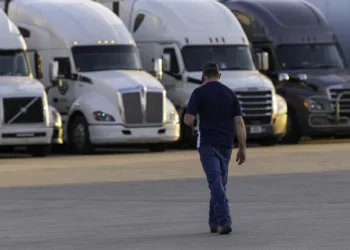UVeye has expanded its automated inspection systems to support commercial fleets, including Class 6-8 trucks and buses. The new platform, specifically engineered for the trucking and bus sector, is compliant with CTP AT17 requirements across the U.S. and U.K. This enables an automated 17-point inspection process.
The company, considered a global leader in the AI-powered vehicle inspection space, was founded in 2016 and developed a machine to scan vehicle underbodies. The technology was initially for homeland security applications such as detecting explosives or suspicious materials at checkpoints. By 2017-18, UVeye expanded to broader uses, including automotive manufacturers, fleet operators and logistics companies.
UVeye’s inspection system uses sophisticated camera arrays and LED lights—dubbed “MRI for vehicles”—that capture thousands of high-resolution images of vehicle components within seconds. These images are then analyzed using deep learning algorithms to identify mechanical issues, safety concerns and cosmetic damage.
“We are setting a new standard for inspections,” said Yaron Saghiv, UVeye’s chief marketing officer, in an interview with FreightWaves. “Traditionally, vehicle inspections are a thing that both in the more heavy-duty vehicles, but also any type of vehicle for you as a car owner or at the rental facility or at the auction or at the manufacturer, wherever it is across the life cycle of the type of vehicle, that’s something that traditionally is being done either very manually or randomly.”
The technology’s systems can also identify issues with tires (wear, mismatched sets, compliance issues), underbody components (leaks, cracks, rust, structural damage) and exterior surfaces (scratches, dents, hard-to-spot flaws).
For fleet operators, particularly in the last-mile delivery space, the technology offers cost-saving advantages through more consistent inspections. Amazon, which announced a partnership with UVeye in 2023, is implementing the technology throughout its Prime delivery network to improve safety and vehicle maintenance. The technology is also in use across hundreds of automotive dealerships, including car rental company Hertz and automaker General Motors.
“It gives you a predictive maintenance side to understand the kind of things that could become a problem,” Saghiv noted. “We can stop the vehicle, fix it on the spot or make sure it’s ready to go later on, and then set it on the road. So, ground it and fix it before the issue becomes something much, much bigger.”
The technology also holds promise for autonomous vehicle fleets, namely by providing automated inspection capabilities at autonomous truck ports.
“The autonomous fleet space is super interesting,” Saghiv said. “It definitely fits that model of an autonomous fleet … vehicle drives through a system, gets an inspection report. If something needs fixing, it gets fixed.”
In the electric vehicle (EV) space, additional sensors—including thermal imaging for electric vehicle battery monitoring—are being integrated to expand detection capabilities.
UVeye notes that the heavy-duty platform is currently being built and tested with select partners, with full availability expected in 2026.
The post UVeye expands AI vehicle inspections to heavy-duty fleets appeared first on FreightWaves.


















